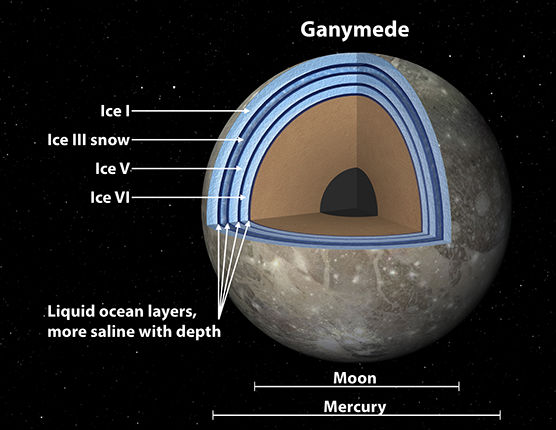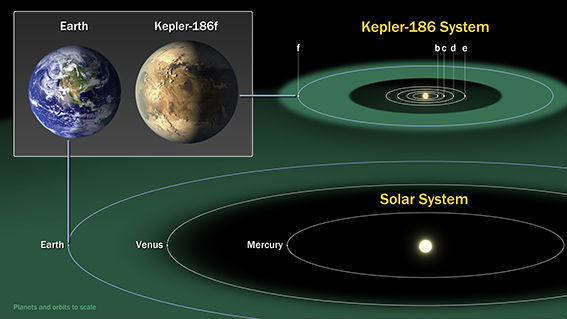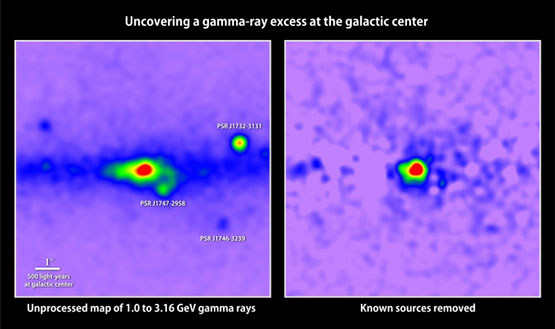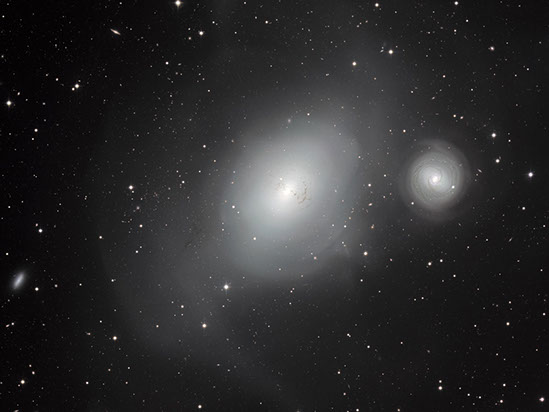



May 2014
Ganymede
Scientists studying Jupiter's moon Ganymede say its surface may be a "club sandwich" of ice and water. It was previously thought that the surface was an ocean of water with ice on the top and bottom. But new studies indicate that it is probably layered with ice and water alternating in different layers the deeper you go.
This new theory is based on the fact that salt changes the density of water in different pressures. The deeper you go on Ganymede, the higher the pressure, thus changing the density of water. In an extreme case such as on Ganymede, the ice is in different forms due to the pressure., thereby producing the layered effect.
The top layer of ice, known as "Ice I", is the common ice we know that is lighter than water. Put an ice cube in a glass of water and it will float. This ice sits on top of a layer of water on Ganymede. But as you go deeper, the pressure builds significantly and the ice crystal structures become more dense. The ice becomes so dense that it becomes heavier than water. In this case the ice will sink below the water. This ice is called "Ice VI".
On Ganymede, the saltiest liquid would sink to the bottom. But as the sea churns, it will begin to "snow" upwards with lighter ice rising and heavier ice sinking. When the ice forms, the salt precipitates out and a middle layer of ice will form, called "Ice III".
The result is that you will have a layer on top of Ice I, with water below, then Ice III, with more water below, and Ice VI, with more water below at the bottom of the "ocean".
Below that is the rocky core of the moon. On Earth, primitive life is formed in deep ocean vents on the sea floor. With this new layered model on Ganymede, because water would be above the rocky core instead of ice, the possibility of life forming is much higher.

Credit: NASA/JPL-CalTech
Close Sun Found
A sun has been discovered only 7.2 light years away from us. Nasa's WISE (Wide-field Infrared Survey Explorer) and the Spitzer Space Telescope have found a cold Brown Dwarf, the fourth closest star to ours. The Alpha Centauri star system (made up of three stars) is the closest at 4.2 light years away.
Brown Dwarfs are very cold stars. This one (named WISE J085510.83-071442.4) ranges between minus 48 C to minus 13 C (-54 to 9 degrees Fahrenheit). Usually Brown Dwarfs are less than 1000 degrees in temperature. This one is the coldest yet found.
Brown Dwarfs are between a planet like Jupiter and a star like our sun. They are too cold to see in visible light, but they show up in infrared, which is how WISE and Spitzer found this one. For more information about Brown Dwarfs and the telescopes, watch our Let's Explore Astronomy - Rigel Astronomy episode on "Space Telescopes".
Visit our sponsors.
For advertising opportunities on this page and our videos, contact
Upcoming Launches
Date: May 28
Launch Vehicle: Soyuz
Launch Site: Baikonur Cosmodrome, Kazakhstan
Description: Soyuz 39 to carry three astronauts to the International Space Station
Habitable Zone Planet
It is called Kepler-186f. It is about the same size as Earth. It orbits its sun at the right distance where water and oceans could form on the surface and life as we know it could exist, a location called the "habitable zone". It is the first Earth-sized planet found orbiting another star that is in this habitable zone.
Kepler-186f is one of five planets in its solar system. The star is known as Kepler-186 and is located about 500 light-years from Earth in the constellation Cygnus. Kepler-186 is an M-dwarf star, about half the size and mass of our sun.
The mass and composition of Kepler-186f are not known. So scientists do not know what the atmosphere or structure of the planet are. They do not know if water exists there or not. Kepler-186f is probably more of an "Earth-cousin" as its star is so small. But this discovery proves that Earth-size planets do exist in the habitable zone orbiting other stars. Scientists will continue to look for an Earth-sized planet orbiting a star the same size as our sun, an "Earth twin".

Image Credit: NASA Ames/SETI Institute/JPL-Caltech
Dark Matter
Independent researchers are looking at what might be the presence of Dark Matter. As of now, Dark Matter cannot be seen and is an unknown substance that makes up about 80 percent of the Universe. But gamma-ray data obtained by the Fermi Gamma-Ray Space Telescope may have "revealed " Dark Matter. Scientists at the Fermi National Accelerator Laboratory, the Harvard-Smithsonian Center for Astrophysics, the Massachusetts Institute of Technology and the University of Chicago have found that there are more gamma-ray emissions at the center of the Milky Way than can be accounted for by known sources.
The researchers took the gamma-ray data and subtracted out the data from known sources. They found that there was more gamma-rays than they could account for. After looking at all known possibilities, it was found that that data was in close agreement with predictions of simple dark matter models.
No one knows what creates dark matter. In theory, it could be caused by WIMPS (Weakly Interacting Massive Particles). Theorists say that when WIMPS collide they may annihilate each other, creating gamma-rays and possibly dark matter.
The excess gamma-rays found at the galactic center of the Milky Way are at energies a billion times greater than visible light.
It is not known if we are seeing signs of dark matter or not. No other explanation exists at the moment however. It will take a lot more research by scientists examining this data as well as looking at gamma-ray data from other locations in our galaxy and in other galaxies. In the meantime, the universe continues to fascinate and amaze.
A Day on an Exoplanet
For the first time, astronomers have determined the length of a day on an exoplanet. Observations with ESO's Very Large Telescope in Chile have determined that the planet Beta Pictoris b rotates once every eight hours. Beta Pictoris b orbits the star Beta Pictoris in the constellation Pictor. It was one of the first exoplanets discovered.
Astronomers used high-dispersion spectroscopy to split light into its constituent colors of the spectrum. Using the Doppler shift, astronomers could determine the speed at which the planet was moving. It was found that the rotational velocity of Beta Pictoris b is almost 100,000 kilometers per hour. In comparison, Jupiter's atmosphere rotates at 47,000 km per hour and Earth rotates at 1674 km per hour. Beta Pictoris b is 16 times larger and 3000 times more massive than the Earth.
Scientists will now use this same technique on other exoplanets.
Galaxy Eater
The Galaxy NCG 1316 is a galaxy eater. New studies of NGC 1316 indicate that it has gobbled up other galaxies in the past. NGC 1316 has some unusual dust lanes within a much larger envelope of stars. It also has unusually small globular clusters indicating it swallowed up another galaxy about three billion years ago.
More evidence appears in remains of stars that have been displaced and flung out into interstellar space. Putting together the data and observations led to the conclusion that NGC 1316 has feasted on several galaxies in the past.
NGC 1316 is also known as Fornax A. Located in the constellation Fornax, it is the fourth brightest radio source known in the sky. The radio waves are produced by objects falling into a supermassive black hole at the center of the galaxy and the radio has also been increased by the energy and fuel obtained by gobbling up these other galaxies.
This image was taken by ESO's La Silla Observatory MPG/ESO 2.2 meter telescope in Chile. The smaller galaxy to the right of NGC 1316 is NGC 1317. By contrast, NGC 1317 seems a normal unaltered galaxy, indicating it has not been a galaxy eater in the past.

Image credit: ESO
Image Credit: T. Linden, Univ. of Chicago
© 2014-2016 Ted Cook Productions LLC. - All Rights Reserved